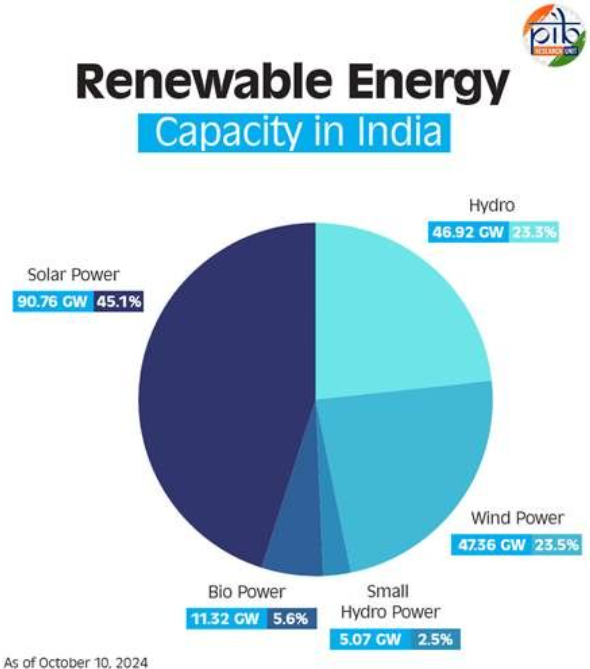What is the extent of the global share of solar energy?
(Source – The Hindu, International Edition – Page No. – 10)
| Topic: GS3 – Economy – Infrastructure – Energy |
| Context |
|
Solar Capacity Growth
- The World Solar Report 2024 by the International Solar Alliance (ISA) reveals that global solar capacity has increased from 1.22 GW in 2000 to 1,419 GW in 2023, achieving a CAGR of 36%.
- Solar energy now accounts for three-quarters of all renewable capacity additions globally.
New Solar Technologies
- Quantum Dot Solar Cells have achieved an efficiency of 1%, enhancing energy capture and enabling atmospheric water harvesting.
- Self-healing solar panels are being developed to extend lifespan and reduce maintenance.
- Solar-powered phyto-mining uses solar energy to extract valuable metals from soil, offering a sustainable alternative to traditional mining.
- Solar paver blocks and Building Integrated PV (BIPV), including transparent solar panels, are integrated with infrastructure to allow light transmission and visibility.
- Innovations focus on reducing reliance on critical materials like lithium and rare earth elements while prioritizing panel recycling and circular economy practices.
Reducing Costs and Global Market Trends
- The cost of utility-scale solar PV has consistently fallen, with average auction prices reaching $40/MWh
- India secured the lowest auction price of $34/MWh.
- China dominates the solar PV market, contributing 43% (609 GW) of the global cumulative capacity, with the U.S. at 10% (137.73 GW).
- Solar PV manufacturing saw nearly double the capacity for wafers, cells, and modules in 2023, with China maintaining a dominant market share.
Impact on Other Industries
- Employment in the solar PV sector grew to 1 million jobs in 2023, highlighting its economic significance.
- Solar-powered irrigation systems and agrivoltaics are transforming agriculture, with solar pumps expected to grow at 8% CAGR from 2021 to 2027.
- Pay-as-you-go business models are increasing solar adoption, especially in developing regions.
Conclusion
- Technological advancements and cost reductions are accelerating the adoption of solar energy, with further focus needed on technology and finance transfer to least developed and small island countries.

| PYQ: India has immense potential for solar energy though there are regional variations in its development. Elaborate. (250 words/15m) (UPSC CSE (M) GS-1 2020) |
| Practice Question: Discuss the role of technological advancements in reducing the cost of solar energy and its impact on global energy markets. How can emerging solar technologies contribute to sustainable development in India? (250 Words /15 marks) |



